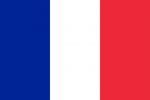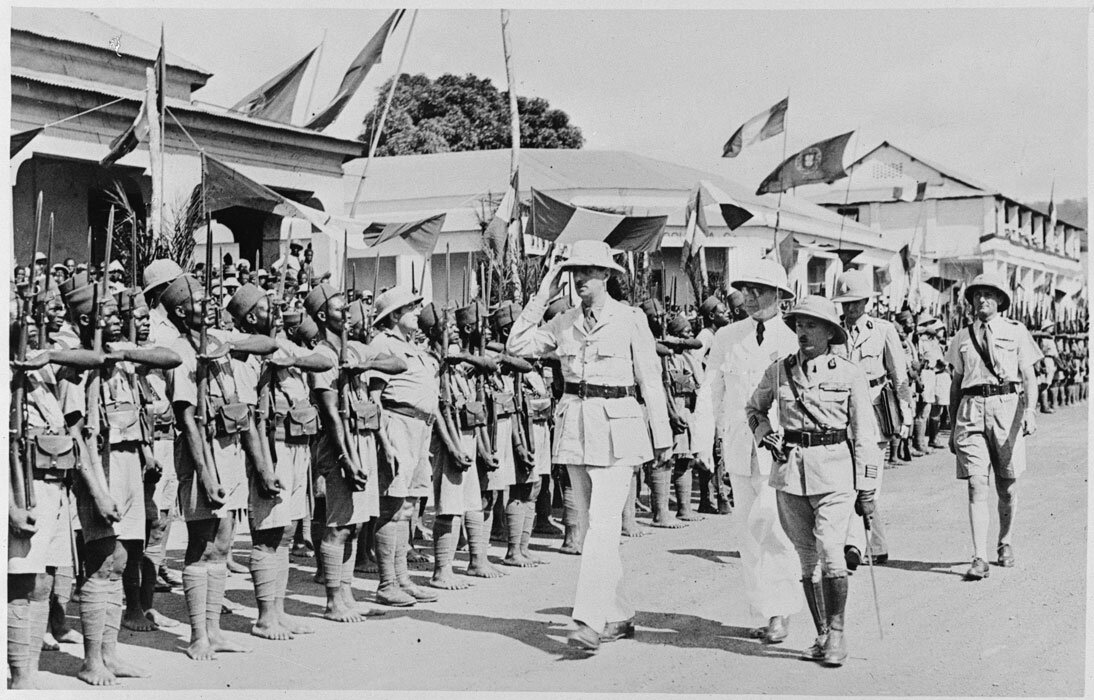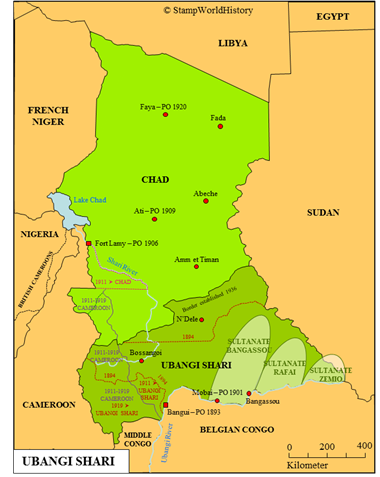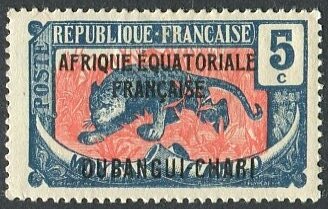
Ubangi-Shari
Quick reference
General issues: Ubangi-Shari-Chad, French postal area 1915-1922, Ubangi-Shari, French colony 1922-1936
Country name on general issues: Oubangui-Chari-Tchad, Oubangui-Chari
Currency: 1 Franc = 100 Centimes 1915-1936
Population: 722 000 in 1915, 833 000 in 1936
Political history Ubangi-Shari
Ubangi-Shari is located in central Africa. The name is derived from the Ubangi and Shari Rivers. The largest part of the population consists of Niger-Congo peoples of which the Baya and Banda are the largest groups. To the north live Nilo-Saharan peoples of which the Sara – also living in neighboring Chad – are the largest group. Traditionally, these peoples have not formed larger polities until, in the 19th century, a number of sultanates is formed – mainly in the southeast of the future Ubangi Shari.
Europeans explore the region from 1885. The French, in 1889, settle in Bangui – the future capital of Ubangi-Shari. Ubangi-Shari is proclaimed a French territory in 1894. The claim of the French has not been uncontested. The Belgians from Belgian Congo – then Congo Free State – have explored the region and signed treaties of protection with sultanates whose territories comprise parts of both Belgian Congo and Ubangi-Shari. The Belgians and the French reach agreement on their spheres of influence through a series of treaties, the borders being established in 1894. The borders with German Cameroon are also established in 1894 – the borders with Sudan in 1899. By 1903, French colonial rule is established in most of Ubangi-Shari.
As part of the French possessions in central Africa, Ubangi-Shari will go through a number of administrative changes. In 1903,[1]Effective 1904. the French possessions in central Africa are grouped together as the federation of French Congo, then consisting of the colonies of Gabon and Middle Congo, the territory of Ubangi-Shari and the French military territory of Chad. In 1906, Ubangi-Shari and Chad are joined to form Ubangi-Shari-Chad. The federation of French Congo is, in 1910, renamed French Equatorial Africa. Ubangi-Shari-Chad is finally split up, again, in 1914 now forming the colony of Ubangi-Shari and the territory of Chad.

1940 – De Gaulle inspecting the Free French Forces. Ubangi Shari was one of the first colonies to join the Free French led by De Gaulle.
The borders of Ubangi-Shari will also change a number of times. In 1911, the French transfer part of French Equatorial Africa – including part of Ubangi-Shari – to German Cameroon as a result of the treaty of Fez – one of the treaties leading up to the establishment of a French protectorate over Morocco. A part that is returned to the French, after WWI, in 1919. The borders within French Equatorial Africa will change more frequently. In the process of the exchange of territories with Cameroon, parts of Middle Congo are, in 1911 and 1919, transferred to Ubangi-Shari. The border with Chad is subject to frequent changes until, in 1936, the border is established as we know it until today.
As in their other possessions in central Africa, the French initially rely on private companies to develop Ubangi-Shari – from 1899, large parts of Ubangi-Shari are contracted out. As this policy proves to be less than successful, it will be aborted from 1919. Cotton is the most important cash crop that is introduced to Ubangi-Shari. The colonial regime does not go without opposition: from 1928 to 1931, the Kongo-Wara rebellion will escalate into one of the major uprisings in the history of French colonial empire.
In 1946, Ubangi-Shari becomes – as do all French possessions – a French overseas territory. From the 1940’s, Ubangi-Shari moves towards independence. In 1958, self government is gained as the Central African Republic. The Central African Republic gains full independence in 1960.
Postal history Ubangi-Shari
In 1893, the first post office in Ubangi-Shari is opened in Bangui using the stamps of the colony of French Congo – the predecessor of the federation of French Congo. As the federation of French Congo is formed in 1904, Ubangi-Shari and Chad are postally administered from Middle Congo, and stamps of Middle Congo are put into use in Ubangi-Shari from 1907. In 1915, the postal administration is transferred to Ubangi-Shari – the postal administration of Ubangi-Shari also including Chad. Thus – although Ubangi-Shari and Chad have, in 1914, become separate political entities within French Equatorial Africa – in 1915 stamps are issued for Ubangi-Shari-Chad.
All general issues for Ubangi-Shari are overprints on stamps of Middle Congo – with the exception of one set issued in 1931 as part of an omnibus issue for France and the French possessions. The first set is issued in 1915 – the overprint reading ‘Oubangui-Chari-Tchad’. In 1922, Chad will gain its own postal administration and, from then on, stamps will be issued for use in Ubangi-Shari only – the overprint now being ‘Oubangui-Chari’. From 1924, stamps are issued with the additional overprint of ‘Afrique Equatoriale Française’. The stamps of Ubangi-Shari are, from 1936, superseded by the issues of French Equatorial Africa and, from 1959, by those of the Central African Republic.
Album pages
← Previous page: TunisiaNext page: Uganda →




